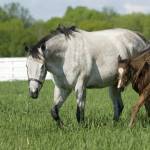Horses on Pasture: When to Graze

In recent years, horse owners have been overwhelmed with warnings about carbohydrate storage, fructans, stressed forage, metabolic syndrome, laminitis risk, and a flood of other statistics related to grass, that seemingly dangerous feedstuff.
Horses have enjoyed unrestricted grazing for centuries, but with new strains of forage, heavy fertilization of pastures, newly diagnosed metabolic complaints, and problems with equine obesity, grass has come under closer scrutiny. While many horses can still graze day after day without developing problems, some classes of horses should have limited pasture access to avoid the serious metabolic upsets triggered by consumption of the sugars in fresh grass.
So, what’s the best time to let these susceptible horses into the pasture? Photosynthesis influences sugar levels in grass. During daylight hours, grasses manufacture and store sugars as they absorb water, sunlight, and carbon dioxide. These stored sugars are used to fuel plant growth during the night. Therefore, sugar levels are at their highest in late afternoon and at their lowest in the very early morning hours.
Horses that are sensitive to carbohydrate levels in pasture grass can graze with least risk from the predawn hours until around 10:00 a.m. This is a time period when stored sugars have been used and have not yet been replenished by photosynthesis. They should not be allowed to graze when sugars are being built up and stored, usually during the sunlight hours and through the early hours of the night.
Season of the year, rainfall, temperature, frequency of mowing, plant types, and grazing pressure also influence the sugar levels in pasture plants. For extremely sensitive horses, there is no completely safe time to graze. These horses are best managed on low-carbohydrate hay with access to a drylot for exercise and social contact.








